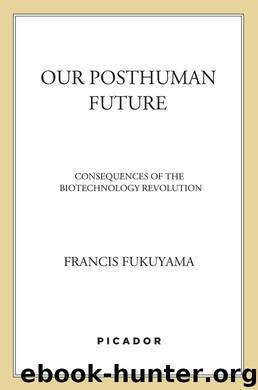Our Posthuman Future by Francis Fukuyama

Author:Francis Fukuyama
Language: eng
Format: epub
Publisher: Farrar, Straus and Giroux
Published: 2011-08-15T16:00:00+00:00
The Tabula Rasa Filled In
Much of what we have learned in recent years about human nature concerns, as we will see below, the species-typical ways in which we perceive, learn, and develop intellectually. Human beings have their own mode of cognition, which is different from that of apes and dolphins, one which is open-ended in the knowledge that it can accumulate, but is not infinitely so.
An obvious example of this is language. Actual human languages are conventional, and one of the greatest gulfs that separates one human group from another is the mutual unintelligibility of different languages. On the other hand, the ability to learn languages is universal and governed by certain biological characteristics of the human brain. In 1959, Noam Chomsky suggested that there were “deep structures” underlying the syntax of all languages;19 the idea that these deep structures are innate, genetically programmed aspects of brain development is widely accepted today.20 It is genes and not culture that ensure that the ability to learn languages appears at some point in the first year of child development and then diminishes by the time a child reaches adolescence.
The idea that there are innate forms of human cognition is one that has received a tremendous amount of empirical support in recent years but has also met a great deal of resistance. The reason for this resistance, particularly in the Anglo-Saxon world, is due to the lasting influence of John Locke and the school of British empiricism that he fostered. Locke begins An Essay Concerning Human Understanding with the assertion that there are no innate ideas in the human mind and, in particular, no innate moral ideas. This is the famous Lockean tabula rasa: the brain is a kind of general-purpose computer that can take in and manipulate the sensory data that appear to it. But its memory banks are essentially blank at the moment of birth.
Locke’s tabula rasa remained a powerfully appealing idea through the middle of the twentieth century, when it was taken up by the behavioralist school of John Watson and B. F. Skinner. The latter advanced an even more radical version, to the effect that there were no species-specific modes of learning, and that pigeons, for example, could be made to recognize themselves in a mirror the way apes and humans could, given the proper rewards and punishments.21 Modern cultural anthropology also accepts the tabula rasa assumption; anthropologists have argued, among other things, that the concepts of time and color are social constructions not present in every culture.22 A great deal of the research emphasis in this field and in the related area of cultural studies over the past two generations has been to seek out the unusual, bizarre, or unexpected in human cultural practices, under the Lockean presumption that a single exception to a general rule will invalidate the rule.
Today the idea of the tabula rasa lies in shambles. Research in cognitive neuroscience and psychology has replaced the blank slate with a view of the brain as a modular organ full of highly adapted cognitive structures, most of them unique to the human species.
Download
This site does not store any files on its server. We only index and link to content provided by other sites. Please contact the content providers to delete copyright contents if any and email us, we'll remove relevant links or contents immediately.
| Anatomy | Animals |
| Bacteriology | Biochemistry |
| Bioelectricity | Bioinformatics |
| Biology | Biophysics |
| Biotechnology | Botany |
| Ecology | Genetics |
| Paleontology | Plants |
| Taxonomic Classification | Zoology |
Sapiens: A Brief History of Humankind by Yuval Noah Harari(14242)
The Tidewater Tales by John Barth(12608)
Mastermind: How to Think Like Sherlock Holmes by Maria Konnikova(7221)
Do No Harm Stories of Life, Death and Brain Surgery by Henry Marsh(6887)
The Thirst by Nesbo Jo(6826)
Why We Sleep: Unlocking the Power of Sleep and Dreams by Matthew Walker(6618)
Life 3.0: Being Human in the Age of Artificial Intelligence by Tegmark Max(5472)
Sapiens by Yuval Noah Harari(5293)
The Longevity Diet by Valter Longo(5017)
The Body: A Guide for Occupants by Bill Bryson(4973)
The Rules Do Not Apply by Ariel Levy(4842)
The Immortal Life of Henrietta Lacks by Rebecca Skloot(4523)
Animal Frequency by Melissa Alvarez(4394)
Why We Sleep by Matthew Walker(4358)
The Hacking of the American Mind by Robert H. Lustig(4318)
Yoga Anatomy by Kaminoff Leslie(4303)
All Creatures Great and Small by James Herriot(4228)
Double Down (Diary of a Wimpy Kid Book 11) by Jeff Kinney(4204)
Barron's AP Biology by Goldberg M.S. Deborah T(4095)
